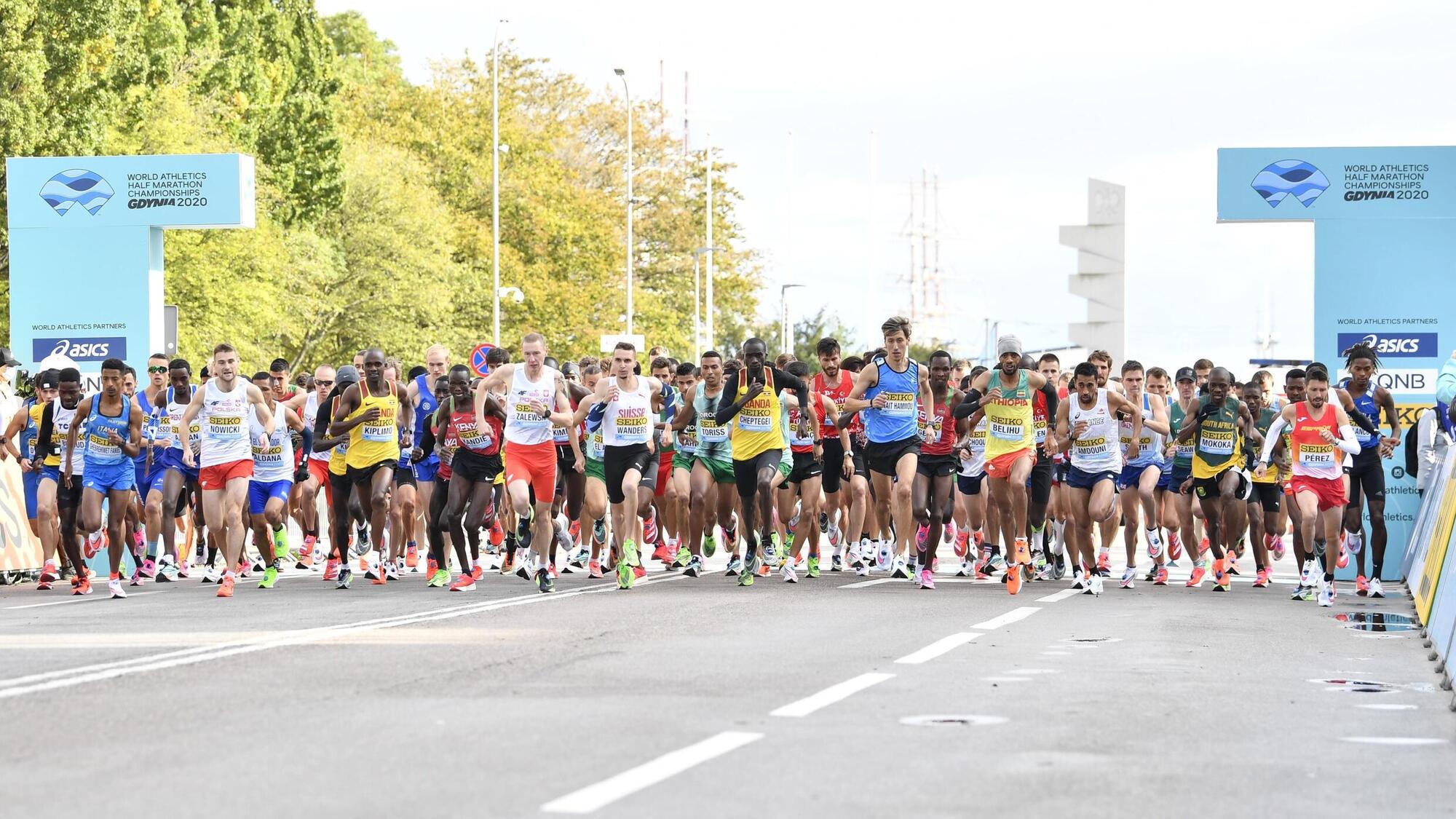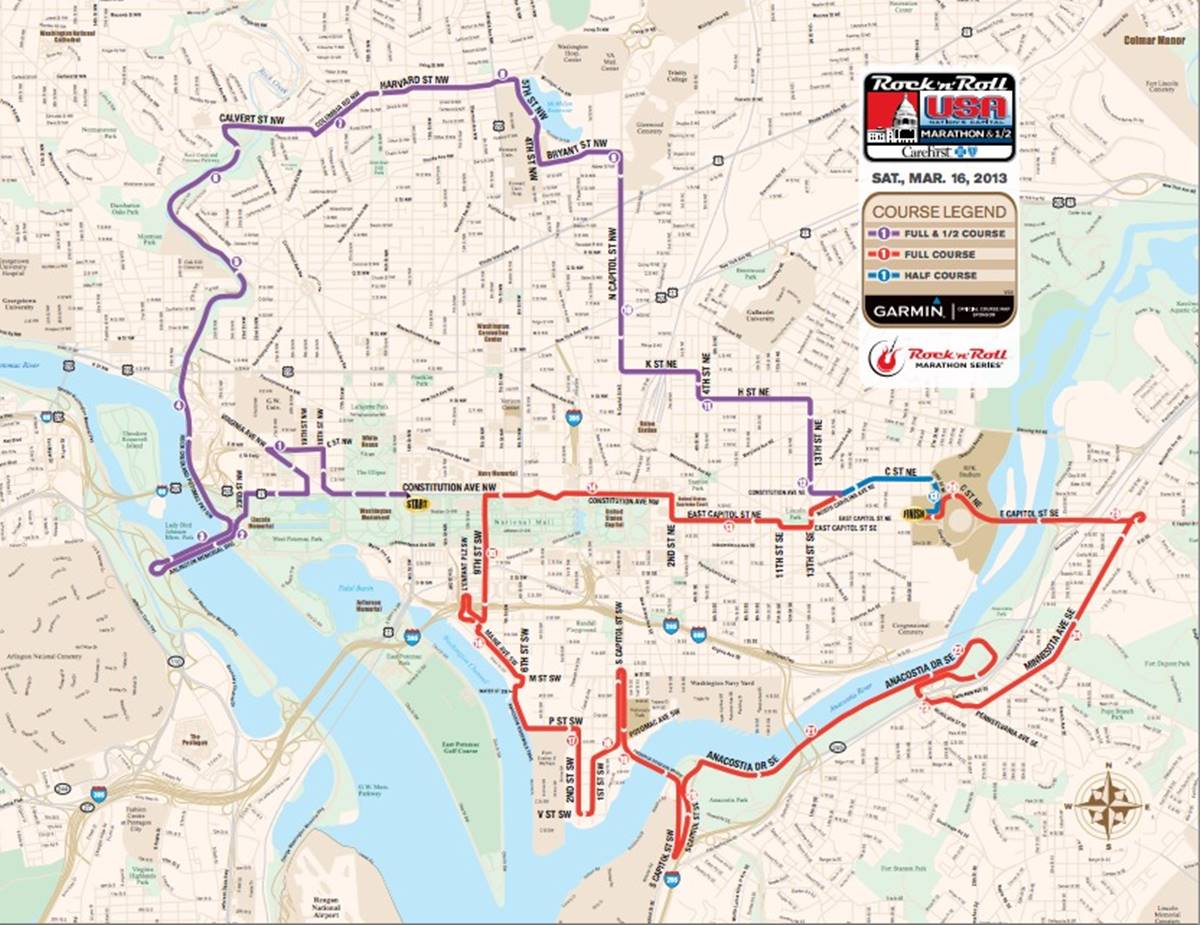Home>Misc>Featured>How Long Does It Take To Go From Half Marathon To Marathon


Featured
How Long Does It Take To Go From Half Marathon To Marathon
Modified: August 21, 2023
Discover the journey of going from a half marathon to a full marathon and find out how long it takes with our featured guide and expert tips.
Introduction
Embarking on the journey from running a half marathon to completing a full marathon is a significant milestone for many runners. The transition from the 13.1-mile distance to the 26.2-mile distance requires a strategic approach to training, patience, and mental fortitude. While it may seem daunting at first, with the right preparation and mindset, anyone can achieve this incredible feat.
Training for a marathon is a step-by-step process that involves gradually increasing mileage, incorporating cross-training and strength training, prioritizing proper nutrition and hydration, and allowing ample rest and recovery. This article will guide you through the necessary steps to make a smooth transition from running a half marathon to conquering a full marathon.
Before diving into the specifics of training, it’s important to acknowledge that every individual’s journey is unique. Your current fitness level, running experience, and personal goals will play a significant role in shaping your training plan. Therefore, it’s crucial to consult with a healthcare professional or a certified running coach to develop a personalized approach that suits your needs.
Throughout this article, we will explore various aspects of the transition, including adjusting your training plan, managing the mental and physical challenges, and setting realistic goals. By following these guidelines and embracing the process, you can set yourself up for success and cross that marathon finish line with pride.
Training for a Half Marathon
Preparing for a half marathon requires a structured training plan that gradually builds your endurance and mileage. The key principles to keep in mind during this phase are consistency, progression, and listening to your body.
Most training plans for half marathons span between 10-16 weeks, depending on your current fitness level and running experience. It’s essential to choose a plan that suits your needs and aligns with your goals. Here are some key elements to consider:
- Base mileage: Before starting a structured program, it’s advisable to have a comfortable running base of 2-3 miles, around 3-4 times a week. This helps prevent injuries and allows for a smoother transition into the training program.
- Long runs: Long runs form the backbone of half marathon training. Gradually increase your long run distance each week to build endurance and confidence. Aim to add 1-2 miles to your long run every week, with a step-back or recovery week every 3-4 weeks.
- Speed work: Incorporating speed workouts, such as tempo runs and intervals, helps improve your overall pace and running economy. These workouts challenge the body to adapt and become more efficient.
- Rest and recovery: Rest days are just as important as training days. Allow your body time to recover and repair itself. Incorporate easy runs and cross-training on rest days to maintain fitness without putting undue stress on your body.
- Cross-training: Engage in activities like swimming, cycling, or strength training to supplement your running. Cross-training enhances cardiovascular fitness, strengthens supporting muscles, and reduces the risk of overuse injuries.
Remember, every individual will respond differently to training. It’s vital to listen to your body and make adjustments as needed. If you feel excessively fatigued or experience pain that persists, it’s essential to seek medical advice.
By following a well-structured training plan, staying consistent, and gradually increasing your mileage and intensity, you will be on your way to successfully completing a half marathon.
Increasing Mileage and Duration
As you progress in your half marathon training, gradually increasing your mileage and duration is crucial for building endurance and preparing your body for the demands of a longer race. Here are some key considerations and guidelines:
- Weekly mileage: Aim to increase your total weekly mileage by no more than 10% to reduce the risk of overuse injuries. This gradual approach allows your body to adapt to the increased workload.
- Long run progression: Each week, extend the distance of your long run by 1-2 miles or by time. However, every 3-4 weeks, incorporate a reduced mileage week to allow for adequate recovery.
- Back-to-back runs: To simulate fatigue and build mental and physical endurance, consider doing back-to-back runs on occasion. This involves running a long run one day and following it with a shorter recovery run the next day.
- Non-consecutive long runs: As you progress in your training, consider adding non-consecutive long runs to your schedule. For example, if you have been doing a long run every Sunday, you can introduce a mid-week long run to further challenge your body’s endurance.
- Speed work and interval training: In addition to increasing your mileage, incorporating speed work and interval training can help improve your running efficiency and overall pace. However, be cautious not to increase both mileage and intensity simultaneously, as it may lead to overexertion and injury.
While it’s important to increase mileage and duration, it’s equally essential to listen to your body and be mindful of any signs of overtraining or fatigue. If you experience excessive soreness, prolonged fatigue, or persistent pain, take a step back and allow for adequate rest and recovery.
Remember, the goal is to gradually build your endurance and fitness over time. Be patient with the process and trust in your training plan. It’s better to increase mileage gradually and stay injury-free than to push too hard and risk setbacks.
Cross-Training and Strength Training
While running is the core component of half marathon training, incorporating cross-training and strength training exercises into your routine is essential for overall fitness and injury prevention. Here’s why cross-training and strength training are beneficial and some key tips to consider:
- Cross-training benefits: Engaging in activities such as swimming, cycling, or using the elliptical machine can help improve cardiovascular fitness, enhance muscle balance, and prevent overuse injuries. Cross-training also provides a mental break from running while maintaining fitness.
- Strength training advantages: Incorporating strength training exercises enhances overall muscle strength, stability, and power. Stronger muscles and improved joint stability contribute to better running form and reduced risk of injuries.
- Fitting cross-training into your schedule: Aim for 1-2 cross-training sessions per week, depending on your availability and recovery needs. Choose activities that engage different muscle groups and complement running without causing excessive fatigue or stress.
- Types of cross-training: Consider low-impact activities such as swimming, cycling, or rowing, which offer cardiovascular benefits without putting additional stress on your joints. Yoga, Pilates, and barre classes can also help improve flexibility, core strength, and balance.
- Strength training exercises: Focus on exercises that target major muscle groups, including the legs, core, and upper body. Squats, lunges, deadlifts, planks, and push-ups are effective exercises to incorporate into your routine. Start with lighter weights and gradually increase the intensity as you progress.
Remember, the goal of cross-training and strength training is to complement your running and develop overall fitness. Be mindful not to overexert yourself or neglect proper rest and recovery. It’s important to strike a balance between running, cross-training, and allowing your body time to repair and rebuild.
By incorporating cross-training and strength training into your routine, you’ll not only improve your running performance but also reduce the risk of injury and enjoy a well-rounded fitness regimen.
Nutrition and Hydration
Proper nutrition and hydration are essential for fueling your body and optimizing performance during half marathon training. Here are some key considerations and guidelines to support your training:
- Eat a balanced diet: Focus on consuming a variety of nutrient-dense foods, including fruits, vegetables, whole grains, lean proteins, and healthy fats. A well-rounded diet provides essential vitamins, minerals, and antioxidants for overall health and energy.
- Carbohydrates for energy: Carbohydrates are the primary fuel source for endurance activities like running. Include complex carbs such as whole grains, legumes, and starchy vegetables in your meals to provide sustained energy for your training runs.
- Protein for muscle repair: Adequate protein intake is crucial for tissue repair and muscle recovery. Include lean sources of protein, such as chicken, fish, tofu, or beans, with each meal to support muscle growth and repair.
- Hydrate properly: Stay hydrated by drinking enough water throughout the day. During long runs or intense training sessions, consider drinking water or electrolyte-rich sports drinks to replenish fluids and electrolytes lost through sweat.
- Timing of meals: Eat a balanced meal or snack containing a mix of carbohydrates and protein 1-2 hours before your training runs for sustained energy. It’s also important to refuel within 30 minutes to an hour after your workout with a combination of protein and carbs to enhance recovery.
- Practice during training: Experiment with different nutrition strategies during your long runs to find what works best for you. Test out different energy gels, chews, or sports drinks to determine what helps maintain your energy levels without causing stomach discomfort.
Everyone’s nutritional needs are unique, so it’s important to pay attention to how your body responds to different foods and hydration strategies. Consider consulting with a registered dietitian specializing in sports nutrition to develop a personalized nutrition plan that meets your specific needs.
Remember, proper fueling and hydration play a significant role in both performance and recovery. By prioritizing nutrition and hydration, you’ll have the energy and strength to tackle your half marathon training and cross that finish line with success.
Rest and Recovery
Rest and recovery are just as important as training when it comes to preparing for a half marathon. Giving your body time to repair and rejuvenate is crucial for injury prevention and overall performance. Here are some key aspects to consider:
- Rest days: Incorporate regular rest days into your training schedule. These days provide your body with an opportunity to recover and adapt to the training stimulus. Avoid excessive activity on these rest days to ensure proper recovery.
- Sleep quality: Aim to get 7-9 hours of quality sleep each night. Sleep is when your body repairs and rebuilds tissues, regulates hormones, and supports immune function. Prioritize establishing a consistent sleep routine to enhance your recovery.
- Active recovery: On rest days or recovery weeks, consider engaging in low-intensity activities like gentle stretching, foam rolling, or yoga. These activities help increase blood flow, promote muscle relaxation, and aid in recovery.
- Listen to your body: Pay attention to any signs of overtraining or fatigue, such as persistent muscle soreness, decreased motivation, or mood changes. If you experience these symptoms, it’s essential to take a step back and allow for extra rest and recovery.
- Massage and self-care: Treat yourself to a massage or invest in self-care practices like using a foam roller or massage balls. These techniques help release tension, improve circulation, and alleviate muscle tightness and soreness.
- Mental recovery: Rest and recovery also include taking care of your mental well-being. Engage in activities that help you relax and reduce stress, such as meditation, reading, spending time with loved ones, or pursuing hobbies you enjoy.
Remember, rest is not a sign of weakness; it’s an essential part of the training process. By allowing your body and mind the time they need to recover, you’ll reduce the risk of injury and be better prepared for the demands of your half marathon training program.
Embrace rest days as an integral part of your training, and give yourself permission to recharge and come back stronger.
Setting Goals and Building Confidence
Setting clear goals and building confidence are fundamental aspects of half marathon training. Having a purpose and a strong belief in your abilities will fuel your motivation and keep you focused throughout the training journey. Here’s how to set goals and boost your confidence:
- Define your goals: Determine what you want to achieve in your half marathon journey. Whether it’s finishing within a certain time, completing your first race, or improving your personal best, setting specific and realistic goals will give you something to strive for.
- Break down your goals: Once you have established your main goal, break it down into smaller, manageable milestones. These can include achieving specific training distances, increasing your speed, or completing certain workouts. Each small accomplishment will build confidence and propel you forward.
- Track your progress: Keep a training journal or use a running app to track your workouts and monitor your progress. Seeing how far you’ve come can be incredibly motivating and boost your confidence. Celebrate your achievements along the way.
- Visualize success: Take the time to visualize yourself crossing the finish line, running strong and confident. Visualizing success helps build mental resilience and reinforces positive beliefs in your abilities. Use visualization techniques during training runs to stay focused and motivated.
- Surround yourself with support: Seek out a running group, join online communities, or find a training partner who shares your passion for running. The support and encouragement from others can provide a tremendous boost to your confidence and help you stay motivated during challenging times.
- Positive self-talk: Replace negative self-talk with positive affirmations and encouraging statements. Remind yourself of your strengths and capabilities. Embrace a growth mindset and believe in your ability to overcome obstacles and reach your goals.
- Embrace setbacks as learning opportunities: Setbacks and challenges are a natural part of the training process. Instead of getting discouraged, view them as opportunities for growth and learning. Learn from your experiences, adjust your approach if needed, and keep moving forward.
Remember, building confidence takes time and effort. Celebrate your progress, focus on the process rather than just the end result, and trust in the training you have put in. By setting goals and cultivating confidence, you’ll develop the mental strength to overcome obstacles and achieve success in your half marathon journey.
Transitioning from a Half Marathon to a Full Marathon
Transitioning from running a half marathon to taking on the challenge of a full marathon is a significant step for any runner. It requires a deliberate and structured approach to training, as well as mental and physical preparation. Here’s how to successfully make the leap:
- Assess your readiness: Reflect on your experience with the half marathon and evaluate whether you feel mentally and physically prepared to take on the increased distance. Consider factors such as your training consistency, recovery, and overall fitness level.
- Adjust your training plan: Transitioning to a full marathon requires gradually building your mileage and long run duration. Modify your training plan to gradually increase your weekly mileage and long run distance, following the principles of progression and consistency.
- Manage mental and physical challenges: Understand that training for a full marathon will bring new challenges. Be prepared for increased fatigue, longer time commitments, and potential moments of self-doubt. Develop strategies to stay motivated, such as adopting a positive mindset, seeking support from fellow runners, and finding joy in the journey.
- Fueling and hydration: Pay extra attention to your nutrition and hydration as you increase your training volume. Ensure you’re consuming the necessary nutrients to fuel your long runs and supporting proper recovery. Experiment with different fueling strategies during training to find what works best for you.
- Recovery and rest: As the demands of marathon training increase, adequate recovery becomes even more critical. Prioritize rest days and quality sleep to allow for proper muscle repair and reduce the risk of overuse injuries.
- Pacing and race strategy: A full marathon requires a different race strategy compared to a half marathon. Consider pacing yourself conservatively, especially in the early miles, to avoid hitting the wall later in the race. Incorporate long runs with marathon pace segments to practice maintaining a steady pace throughout the race.
- Mental preparation: Mentally preparing for a full marathon is just as important as physical training. Visualize yourself crossing the finish line, practice positive self-talk, and develop mental strategies to stay focused and motivated during challenging moments.
Remember, transitioning to a full marathon is a significant undertaking, but with proper preparation, mindset, and determination, you can achieve this remarkable feat. Embrace the journey, trust in your training, and savor the incredible sense of accomplishment that comes with crossing the marathon finish line.
Adjusting Training Plan
When transitioning from a half marathon to a full marathon, it’s important to adjust your training plan to accommodate the increased distance and prepare your body for the heightened demands of the marathon. Here are some key considerations for adjusting your training plan:
- Gradual mileage increase: Gradually increase your weekly mileage to allow your body to adapt to the higher volume of training. Aim for a weekly mileage increase of no more than 10%, ensuring that you have adequate recovery time between runs.
- Long run progression: Adjust your long run distance gradually over the course of your training. Add approximately 1-2 miles to your long run each week, with periodic step-back weeks where you reduce the mileage to allow for recovery.
- Introduce back-to-back long runs: As you progress in your training, consider adding back-to-back long runs to simulate the fatigue you may experience in a marathon. This involves completing a long run on one day and following it with another medium-distance run the next day.
- Include marathon-specific workouts: Incorporate workouts that help you develop the necessary endurance and mental toughness for the full marathon. These workouts may include longer marathon pace runs, tempo runs, and hill repeats.
- Focus on endurance: The full marathon requires a stronger emphasis on endurance compared to the half marathon. Make sure your training plan includes long runs of at least 18-20 miles to adequately prepare your body for the full distance.
- Balance speed work and mileage: While speed work is still valuable, it’s important to strike a balance between increasing mileage and maintaining speed. Consider reducing the frequency or intensity of your speed workouts to ensure you have enough energy for your long runs and recovery.
- Listen to your body: Adjusting your training plan also means being attuned to your body’s needs. Pay attention to any signs of overtraining, fatigue, or injury. If necessary, modify your plan to incorporate extra rest days or seek guidance from a running coach or healthcare professional.
Remember, adjusting your training plan to prepare for a full marathon requires careful consideration and a gradual approach. Be patient with your progress, trust in the process, and make adjustments as needed to ensure you are adequately prepared for race day.
Managing Mental and Physical Challenges
When training for a full marathon, you will inevitably face both mental and physical challenges along the way. Learning to effectively manage these challenges will play a crucial role in your success. Here are some strategies to help you navigate the ups and downs of marathon training:
- Develop a positive mindset: Cultivate a positive and resilient mindset. Believe in your ability to overcome obstacles and trust in the training you have put in. Reframe challenges as opportunities for growth and learning.
- Break it down: The marathon distance can seem overwhelming, but breaking it down into smaller, manageable segments can make it more manageable. Focus on running one mile at a time, reaching aid stations, or milestone markers along the course.
- Practice mental strategies: Incorporate mental strategies into your training runs, such as visualization, positive self-talk, and mindfulness techniques. These techniques can help you stay present, focused, and motivated during challenging moments.
- Maintain a support system: Surround yourself with supportive friends, family, and fellow runners who understand the demands of marathon training. Lean on them for encouragement, advice, and motivation throughout your journey.
- Embrace the discomfort: Acknowledge that marathon training is physically demanding and uncomfortable at times. Accept that discomfort is a normal part of the process and focus on embracing the challenge instead of avoiding it.
- Set realistic expectations: Understand that not every run will be perfect, and there will be setbacks along the way. Set realistic expectations for yourself and be flexible in adjusting your goals or training plan when needed.
- Celebrate small victories: Recognize and celebrate your achievements along the way, no matter how small. Completing a challenging workout or achieving a personal best in a shorter race can boost your confidence and keep you motivated.
- Take care of your body: Prioritize self-care by getting enough sleep, eating nutritious foods, staying hydrated, and listening to your body’s cues. Taking care of your physical well-being will contribute to your mental resilience.
- Remember your why: Reflect on your motivation for taking on the full marathon. Whether it’s personal growth, achieving a goal, or a cause you’re passionate about, keep your why at the forefront of your mind during the toughest times.
Remember, marathon training is not just a physical journey; it’s a mental one as well. Building mental resilience, managing challenges, and staying positive will help you overcome obstacles and cross the marathon finish line with pride.
Conclusion
Transitioning from a half marathon to a full marathon is an exciting and rewarding journey that requires careful planning, dedication, and perseverance. By following a structured training plan, gradually increasing mileage, incorporating cross-training and strength training, fueling your body with proper nutrition and hydration, prioritizing rest and recovery, setting goals, and building confidence, you can successfully make the leap to the full marathon distance.
Throughout the training process, you will encounter physical and mental challenges. It’s important to stay positive, embrace the discomfort, and develop effective strategies for managing setbacks and staying motivated. Listen to your body, be flexible with your training plan, and seek support from fellow runners and professionals when needed.
Remember that marathon training is not just about reaching the finish line; it’s about the journey itself. Celebrate the small victories along the way, cherish the progress you make, and trust in the process. The marathon distance is a test of your physical and mental strength, but with proper preparation and a determined mindset, you can conquer the challenge and experience the incredible sense of accomplishment that comes with crossing the marathon finish line.
So lace up your running shoes, set your goals, and embark on this incredible adventure. Embrace the training, believe in yourself, and let the marathon become a defining moment in your running journey. Remember, you are capable of achieving more than you can imagine. Good luck!









